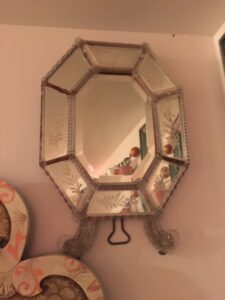 Before the 17th century people without incredible money who wanted to know what they looked like, stared in a pool of water. The idea of mirrors, so ubiquitous today, was unheard of, except for the extremely wealthy, until the 19th century.
Before the 17th century people without incredible money who wanted to know what they looked like, stared in a pool of water. The idea of mirrors, so ubiquitous today, was unheard of, except for the extremely wealthy, until the 19th century.
JE sent me two wonderful 19th century Venetian glass mirrors. I pegged them as Venetian from the design of the frames, the diamond cut etching on one, and the turned glass rods on the smaller one. I see their history as the history of mirrors themselves.
History of Mirrors
To see oneself goes back to the mirrors of Egypt in the first century BC. Wealthy people owned brass, silver, or a copper polished METAL mirror, very slim, and handheld. Glass mirrors didn’t exist until the 15th century. On the island of Murano a glass blower figured a way to add glass crystals to molten glass. Later, in the 16th century, those Venetian glassblowers figured out how to roll a sheet of glass virtually flat. The glass manufactures on the island of Murano became the first to make glass mirrors. These mirrors shook the noble world. Henry the VIII and Francis the First collected Venetian glass mirrors.
People saw what they looked like for the first time. Elaborate frames were developed for these relatively small mirrors. Fine frames, meant to set off the reflection, also adorned mirrored glass, etched, and mounted on elaborate wood frames.
In the late 16 century Marie de Medici ordered 119 glass mirrors sent to the Court of France from Murano. French artisans marveled at these mirrors, found it hard to believe the world never saw such a thing before. Colbert, the minister of State, secretly smuggled over three eminent glass masters from Murano. He intended to move the center of the mirror making world from Venice to Paris. The Italians, the three smuggled, taught the French artisans a few of their coveted secrets. Out of that conspiracy came the 17th century Hall of Mirrors in Versailles.
These masters developed a technique for rolling glass FLAT, essential for a true reflection. A large pane of glass seemed impossible so they created these mirrors in sections. The French learned that gold leaf and tin added to the glass added reflectivity. The addition of lead to the clear glass made the glass WHITE and clear. Now France became a player in the game of vanity.
The hall of Mirrors at Versailles ended up with 306 mirrors in the Venetian manner.
More Than Just a Mirror
In the 17th century a mirror served two purposes. It showed someone their image, and they often used it behind a light source to reflect back candlelight. In the 15th and 16th century to afford the price of a mirror, no matter how small, cost as much as a sea- worthy ship.
 Venetian artists developed a technique for adding chemicals to glass. They called it the Lattino process, meaning they added various natural elements before pouring molten glass into molds. The secret to the best Murano mirrors was the addition of gold leaf before the glass annealed. While still hot they rolled it flat by hand. This flat rolling technique became a privileged because of a ban on any foreign interests coming into ”La Serenissima,” the Venetian Republic. Jealously guarded by the Venetian “Council of Ten,” eminent glass blowers who KNEW the secret of melting glass added fractured tin, lining the black of the glass, and adding gold and bronze in the annealing process.
Venetian artists developed a technique for adding chemicals to glass. They called it the Lattino process, meaning they added various natural elements before pouring molten glass into molds. The secret to the best Murano mirrors was the addition of gold leaf before the glass annealed. While still hot they rolled it flat by hand. This flat rolling technique became a privileged because of a ban on any foreign interests coming into ”La Serenissima,” the Venetian Republic. Jealously guarded by the Venetian “Council of Ten,” eminent glass blowers who KNEW the secret of melting glass added fractured tin, lining the black of the glass, and adding gold and bronze in the annealing process.
ANY public bathroom would have been considered an absolute wonder in in the 16th and 17th century anywhere in the world. And to see your own reflection was a treat only the noble people and wealthy aspired to. These days, after such a person as me has not gone to a hairdresser in nineteen months, I consider it a honor NOT to have that wall-wide 20th century bathroom mirror.
The value of both JE’s mirrors is $1,000.